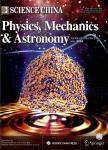Formation and evolution mechanisms of large-clusters during rapid solidification process of liquid metal Al
Formation and evolution mechanisms of large-clusters during rapid solidification process of liquid metal Al作者机构:Department of Applied Physics Hunan University Changsha 410082 China College of Materials Science and Engineering Hunan University Changsha 410082 China College of Chemistry and Chemical Engineering Hunan University Changsha 410082 China
出 版 物:《Science China(Physics,Mechanics & Astronomy)》 (中国科学:物理学、力学、天文学(英文版))
年 卷 期:2005年第48卷第1期
页 面:101-112页
核心收录:
学科分类:07[理学] 070205[理学-凝聚态物理] 0702[理学-物理学]
基 金:The authors thank Professor A.B.Yu School of Material Science and Engineering UNSW Australia for the large-scale computation conditions.This work was supported by the National Natural Science Foundation of China(Grant Nos.50071021 50271026)
主 题:liquid metal, solidification process, large-cluster configuration, evolution mechanism, computer simulation.
摘 要:A molecular dynamics simulation study has been performed for the formation and evolution characteristics of nano-clusters in a large-scale system consisting of 400000 atoms of liquid metal Al. The center-atom method combined with pair-bond analysis technique and cluster-type index method (CTIM) has been applied here to describe the structural configurations of various basic clusters. It is demonstrated that both the 1551 bond-type and the icosahedral cluster (12 0 12 0) constructed by 1551 bond-types are dominant among all the bond-types and cluster-types, respectively, in the system and play a critical role in the microstructure transitions of liquid metal Al. The nano-clusters (containing up to 150 atoms) are formed by the combination of some middle and small clusters with distinctly different sizes, through mutual competition by unceasing annex and evolution in a seesaw manner (in turn of obtaining and losing),which do not occur as the multi-shell structures accumulated with an atom as the center and the surrounding atoms are arranged according to a certain rule. This is the essential distinction of nano-cluster in liquid metal from those obtained by gaseous deposition, ionic spray methods, and so on. Though the nano-clusters differ from each other in shape and size, all of them possess protruding corners that could become the starting points of various dendrite structures in the solidification processes of liquid metals.



